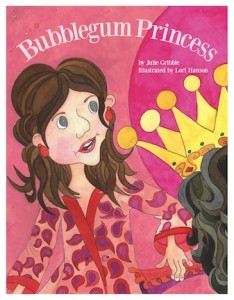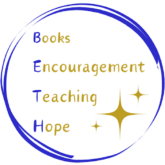
It’s the second Monday of the month, and that means it’s time for Julie Gribble’s guest post series on How to Make a Picture Book. I love the subtitle of today’s post: Choosing your Illustrator/Choosing your Author or How to Find a Best Friend for You and Your Story. If you missed the first post in the series, last month, click here.
If you have any questions, or would like more information on anything Julie and Lori cover in today’s post, please ask in the comments, and Julie will answer in her next post. Thank you!
~ ~ ~
When I first met Lori at the 2011 SCBWI Winter Conference, I saw this beautiful illustration tucked into her badge ID: (Click each image to enlarge, then click the magnifying glass for even more detail)

Notice the flair in his pants, his socks and sneakers, his crazy red hair; the owl, that magnificent tree, and the toothbrush floating past the moon in a swirling blue night sky!
I was truly impressed. Lori was a landscape artist, highly trained and immensely talented, but could she illustrate a character driven picture book? I decided to check out her website and here are a few enchanting characters I found there.

A boisterous tree bellowing an aria from his favorite opera.

Two trees tangled in a minuet.

An inquisitive young tree who’d dashed across a field to have one last conversation with the sun before bedtime.

An old, strong tree who once had branches thick with leaves. He spends most of his time thinking and occasionally checking how high the grass has grown since he’d last looked.

And I found this scene. A trailer built for two tucked away in the woods.
Lori’s illustrations obviously showed how inspired she’d been by the collaborative works that Geisel and Sendak produced while hiking in the Sierra Nevada foothills. I made that up. Geisel and Sendak never hiked together as far as I know. Nor did they ever collaborate, but if their illustrations had, this is what they might have looked like.
Choosing your Illustrator
Feeling at ease with an illustrator and enjoying her company is a good start. After visiting her website, I found that Lori’s illustrations and I were compatible, too 🙂 I had a sense of Lori’s expertise by the confidence in her line and composition, and felt her style was right for my story.
LORI: I came over to the world of children’s illustration from a fine arts background, painting landscapes mostly of the Sierra Nevada foothills and the oak forests where I live. This is more closely aligned with character development of children’s books than one might think. Each oak tree out here has its own personality, certainly its own visual personality, so the trees have educated me in a sense, about the complexities of character.
A quirky, contemporary tale might call for quirky, contemporary illustrations. The story dictates the style and choosing which style best supports the story is one of the many brilliant things Art Directors do.
A few questions that might help you when looking for an illustrator are:
Do her illustrations have a story to tell?
Do they hold your interest?
Are they well executed?
Do they evoke an emotional response?
Do they inspire you?
Would you like her to draw your characters?
If the answer to all the questions above is “yes” then great!
Choosing your Author
I’d heard this tale about the making of the opera, Tosca: Composer, Alberto Franchetti, was chosen to write the music for the adaptation of Victorien Sardou’s play, La Tosca. But Franchetti couldn’t hear the music in the text of the play, he tried, but he found no inspiration in the story. Giacomo Puccini could hear the music and went on to compose one of his most popular operas.
We writers feel lucky when other artists are inspired by our stories. At our first lunch, I shared the idea for Bubblegum Princess with Lori. Lori didn’t laugh or doze off, so that was a good sign.
LORI: Needless to say when I met Julie during the last lecture of my first SCBWI conference, I was thrilled. After the conference, I had to first recover from the pneumonia that I had developed while there — some ill effect of the northeastern cold weather on a California girl. The reason I mention this is because lying in a hotel room for a week gave me time for much day dreaming and scribbling of my ideas for this story. I find the subconscious is so very close to the dream realm of sleeping.
I found this quote: “The long summer of childhood is magical and free of adult responsibilities,” and this is how our long distance interaction proceeded. We liked what we saw in each other’s work, and the project blossomed.
When reading an author’s story, ask yourself:
Do you like the story?
Does it hold your interest?
Is it well executed?
Does it evoke an emotional response?
Does it inspire you?
If the answer to all the questions above is “yes” then you’re both off to a great start.
Next in this series: Story and Character Development – A Collaboration: Lori and Julie at work.
~ ~ ~
Biographical information:
Julie Gribble was the first picture book author accepted into the Stony Brook Southampton Children’s Literature Fellows program and has been mentored by Emma Walton Hamilton and Cindy Kane Trumbore. She’s a full-time writer and a member of SCBWI, ChLA, and BAFTA.
Lori Hanson received her Master of Fine Arts from the San Francisco Art Institute and served an apprenticeship under celebrated artist Gregory Gillespie. She’s a member of SCBWI.
Bubblegum Princess, a picture book inspired by the Duke and Duchess of Cambridge, has received a First Place Royal Dragonfly Children’s Picture Book Award and a nomination for a Cybils Award.
Links:
You can find Julie at the NY Media Works website.
You can find Lori at her website.
You can find Bubblegum Princess at her website or on Amazon.
~ ~ ~
Julie welcomes your questions — if you have any questions about the independent publishing process, please leave them in the comments. Thank you!

So interesting to think of the project from both points of view. One question I have is about style. The kind of art that appeals to me, might not be the kind of art that is trendy or likely to appeal to today’s readers. How can you tell if what you like is what others might like (realizing of course that everyone’s tastes are different and you can’t please everyone)? Is there such a thing as types of art going out of style, or is there still room for any kind of art? For example, I am much more inclined toward the art of Kevin Henkes than David Cattrow.
Hi Susanne! That’s an awesome question. During my first SCBWI conference, where I met Lori, I also met Jane Yolen. She was part of a panel discussion on picture books. While at the conference, I’d been hearing that picture book word counts were trending towards 500 words or less – the fewer the better, so I spoke to Jane about it after picking up a PB book of hers that was much longer than 500 words. She’d also written PBs with fewer words of course, but her advice was to not follow trends, write the story you need to write, because trends change.
I don’t know if what I like will appeal to others either. Even my tastes change, so I try to let the story be the guide.
I’m not certain if there is one style of illustrating that appeals to more readers than others, it’s such a subjective thing, but I can see how certain styles might fit nicely with certain stories. What do you think?
I think that’s right. Some stories need soft gentle pastels and others need bright bouncy primary colors, some need detailed drawings and others need simple line drawings… So I think in the end it should be dictated by the type and mood of the story. As long as the story and the art go well together, and complement each other, hopefully no one will mind which style of art was chosen 🙂
Beautifully said, Susanna.
What a great post! This will help me a lot! 🙂
Thank you Erik. Lori and I are happy to help!